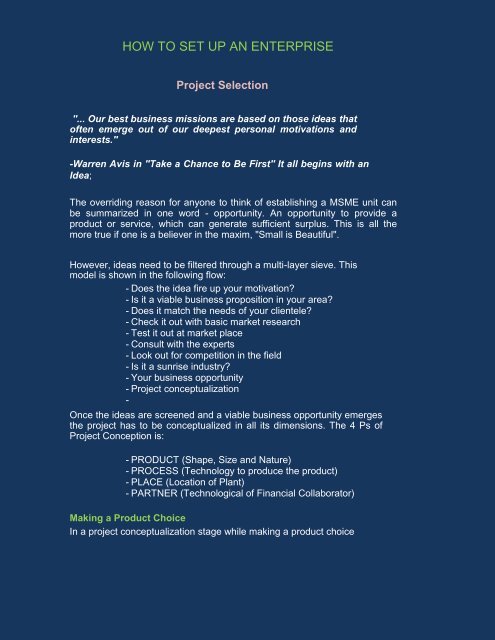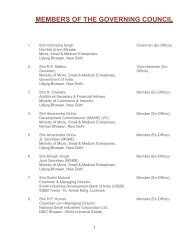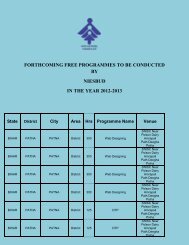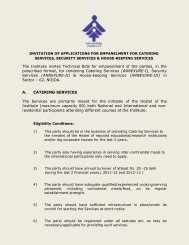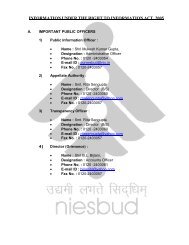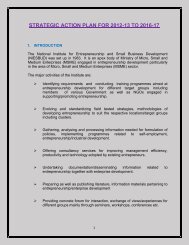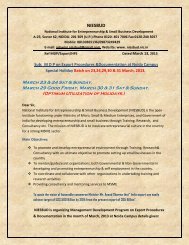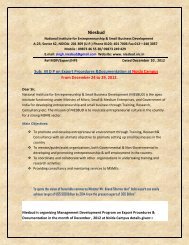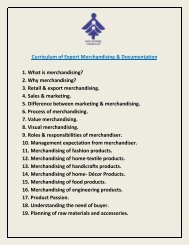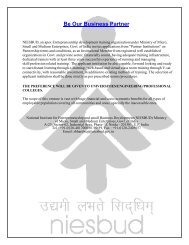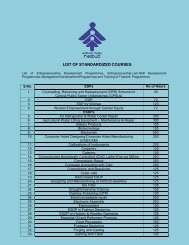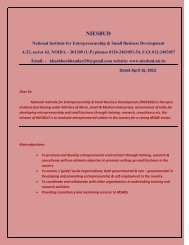HOW TO SET UP AN ENTERPRISE - niesbud
HOW TO SET UP AN ENTERPRISE - niesbud
HOW TO SET UP AN ENTERPRISE - niesbud
You also want an ePaper? Increase the reach of your titles
YUMPU automatically turns print PDFs into web optimized ePapers that Google loves.
<strong>HOW</strong> <strong>TO</strong> <strong>SET</strong> <strong>UP</strong> <strong>AN</strong> <strong>ENTERPRISE</strong><br />
Project Selection<br />
"... Our best business missions are based on those ideas that<br />
often emerge out of our deepest personal motivations and<br />
interests."<br />
-Warren Avis in "Take a Chance to Be First" It all begins with an<br />
Idea;<br />
The overriding reason for anyone to think of establishing a MSME unit can<br />
be summarized in one word - opportunity. An opportunity to provide a<br />
product or service, which can generate sufficient surplus. This is all the<br />
more true if one is a believer in the maxim, "Small is Beautiful".<br />
However, ideas need to be filtered through a multi-layer sieve. This<br />
model is shown in the following flow:<br />
- Does the idea fire up your motivation<br />
- Is it a viable business proposition in your area<br />
- Does it match the needs of your clientele<br />
- Check it out with basic market research<br />
- Test it out at market place<br />
- Consult with the experts<br />
- Look out for competition in the field<br />
- Is it a sunrise industry<br />
- Your business opportunity<br />
- Project conceptualization<br />
-<br />
Once the ideas are screened and a viable business opportunity emerges<br />
the project has to be conceptualized in all its dimensions. The 4 Ps of<br />
Project Conception is:<br />
- PRODUCT (Shape, Size and Nature)<br />
- PROCESS (Technology to produce the product)<br />
- PLACE (Location of Plant)<br />
- PARTNER (Technological of Financial Collaborator)<br />
Making a Product Choice<br />
In a project conceptualization stage while making a product choice
Following factors are related to product need to be considered:<br />
- Product Line - Depth, Width<br />
- Packaging<br />
- Branding<br />
- Warranties<br />
- After Sales Service<br />
Some other factors that one should consider while finalizing the<br />
product choice are:<br />
- Ease of availability of raw-material<br />
- Process Technology<br />
- Accessibility to the market<br />
- Incentive and support from Government<br />
-<br />
Market information is also important for product selection. Products,<br />
which are likely to have a number of players in the market, are best<br />
avoided. Some such products in the recent past have been plastic<br />
footwear, audio cassettes, disposable gloves and bulk drugs. In<br />
case the entrepreneur is looking for a product, which has export<br />
potential, the following additional questions need to be asked:<br />
-What should be the contents of export-product portfolio<br />
- What are the special requirements for packaging if one<br />
has to export the products<br />
- What product adaptations are needed to be<br />
made for exporting a product to a specific<br />
country<br />
- Are any W<strong>TO</strong> conditions involved e.g. "child labor free",<br />
ISO 9000 certified, GMP followed etc.<br />
The development of export-product portfolio can be done by<br />
considering 4 parameters viz.<br />
- External demand conditions<br />
- Internal supply capability<br />
- Complexity of marketing tasks<br />
- Amount of investment required to penetrate the market<br />
-<br />
Analysis can be conducted using this four dimensional model. The<br />
obvious choice is a product which scores a high rating on first two<br />
parameters and low rating on last two parameters.<br />
EXIM (Export Import Bank of India) Bank has also developed an<br />
excellent model to conduct the export-product portfolio analysis based<br />
on three parameters viz.<br />
- Supply Capability In Product Group
- Domestic Environment<br />
- Export Market Attractiveness<br />
This analysis gives rise to product groups with high potential or low<br />
potential. With regard to special packaging requirements one has<br />
to be careful about laws of the country one is exporting to. For<br />
instance, while exporting to Australia, wooden-packaging cannot<br />
be done. Product adaptations for country's specific needs look into<br />
things like whether voltage supply is 220V or 110V for electric<br />
appliances and for automobiles whether left-hand drive or righthand<br />
drive is appropriate. It has now become important to<br />
understand the implications of the various agreements which form<br />
part of W<strong>TO</strong>. Once the product is finalized, choices of process<br />
technology emerges.<br />
Process Selection<br />
Technology and Machinery<br />
Choices of process technology emerge once the product is finalized.<br />
For some complex products, process know how has to be imported. In<br />
such cases agreements for technology transfer should be made with<br />
due care to safeguard interest. A lot of appropriate technology is<br />
being developed at CSIR and Defense Research Labs and some of<br />
this technology can now be bought. Indigenously developed process<br />
know-how has intrinsic benefits such as appropriateness and relative<br />
inexpensiveness. While checking out on a process technology, the<br />
following things need to be considered with utmost care:<br />
- Whether process requires very high level of skilled workers or<br />
complex machines<br />
- Whether process requires large quantities of water and/or power<br />
- Whether any process or product patent needs to be honored while<br />
utilizing the selected process technology.<br />
- Any special pollution or environmental regulations.<br />
- Finally, the appropriateness to the Indian environment and<br />
conditions. Machinery and equipment<br />
One of the major deficiencies in the micro, small and medium<br />
enterprises scenario is the prevalence of outdated production and<br />
management methods hindering the efficient operation of micro, small<br />
and medium-scale units. It was also found that the most important<br />
reason for the reluctance of the small industrialists to install modern<br />
machinery and equipment was the lack of investible funds. The main
objective of National micro, small and medium enterprises (NMSME)<br />
is to provide machinery and equipment to small industrial units<br />
Offering them long repayment period with moderate rate of interest.<br />
NSIC procedures for hire purchase of machinery:<br />
- The hire purchase application is to be made on the prescribed form.<br />
- The Director of Industries of the State under whose jurisdiction the<br />
applicant falls, forwards the application to the head office of the<br />
NSIC at Delhi with his recommendation and comments.<br />
- All applications for indigenous or imported machines are considered<br />
by acceptance committees comprising of the representatives of the<br />
Chief Controller of Imports, Development Commissioner, micro,<br />
small and medium enterprises and other concerned departments.<br />
- Decision of these committees is conveyed to the parties concerned<br />
with copies to the regional offices of the NSIC and the concerned<br />
Directorate of Industries.<br />
- Once all these formalities are completed by the hirer, instructions<br />
are sent to the suppliers to dispatch the consignment (duly insured<br />
for transit risk) to the hirer and to send the R/R or C/R as the case<br />
may be, to the regional office<br />
- The NSIC after ensuring that all dues have been paid by the hirer,<br />
releases the R/R or C/R to him for taking delivery of the<br />
machines.<br />
- In case of imported machines, the procedure is slightly different in<br />
as much as the shipping documents are sent to the clearing agents<br />
for clearing the consignment from the Customs and dispatching it to<br />
the hirer.<br />
Value of machines that can be supplied<br />
Rs. 7.5 Lacks, F.O.R. or landed cost as the case may be.<br />
Earnest Money<br />
5. % or 10% of the value of machinery depending on whether the<br />
equipment is imported or indigenous. In the case of furnaces and a<br />
few other items of equipment, the rate of earnest money is different.<br />
Interest 9 per cent per annum with a rebate of 2 per cent on prompt<br />
payment. This interest is calculated on the value of machines<br />
outstanding after deducting payment of earnest money<br />
Administrative Charge<br />
2 per cent on the sales value of machines and its recovery by<br />
the NSIC is spread over the total installment period.
Period of Repayment-<br />
The value of the machines, after deducting the earnest money received, called the<br />
Balance Value, is payable along with interest and administrative charge in 7 years.<br />
- The first installment is payable after one year and six months from the delivery<br />
of machines<br />
- The second and subsequent installment is payable half-yearly thereafter.<br />
Gestation Period-<br />
In case of certain type of machines which become operative immediately on<br />
installation in the service sector industries and job order establishment, a gestation<br />
period of only 6 months shall be allowed both to the new and existing units.<br />
A rebate of 2% per annum is allowed on the interest rates, in case an installment is<br />
paid on or before the due date.<br />
In case the payment of installment is not made within one month of the specified due<br />
date, interest @ 2% per annum over and above the normal rate is charged on the<br />
defaulted amount from the date of default to the date of actual payment. Remission<br />
in interests is allowed in case one or more than one installment is paid in advance of<br />
the due date(s).<br />
Now the Place and Right Partner has to be selected and Project Report<br />
has to be prepared.<br />
Arranging Finance<br />
No MSME unit can take off without monetary support. This need for finance can be<br />
classified into following types:<br />
- Long and medium term loans<br />
- Short term or working capital requirements<br />
- Risk Capital<br />
- Seed Capital/Marginal Money<br />
- Bridge loans<br />
Financial assistance in India for MSME units is available from a variety of institutions.<br />
The important ones are:<br />
(i) Commercial/Regional Rural/Co-operative Banks.<br />
(ii) SIDBI: Small Industries Development Bank of India (refinance and direct lending)<br />
(iii) SFCs/SIDCs: State Financial Corporations (e.g. Delhi Financial<br />
Corporation)/State Industrial Development Corporations.
Long and medium term loans are provided by SFCs, SIDBI and SIDCs. Banks also<br />
finance term loans. This type of financing is needed to fund purchase of land,<br />
construction of factory building/shed and for purchase of machinery and equipment.<br />
The short-term loans are required for working capital requirements, which fund the<br />
purchase of raw materials and consumables, payment of wages and other immediate<br />
manufacturing and administrative expenses. Such loans are generally available from<br />
commercial banks. The commercial banks also sanction composite loan comprising of<br />
working capital and term loan up to a loan limit of Rs.1 crore.<br />
For loans from financial institutions and commercial banks a formal application needs to<br />
be made. The details of documentation that need to be provided with the loan<br />
application are indicated below:<br />
- Documentation for Loan Application<br />
- Balance Sheet and Profit Loss Statement for last three consecutive years of firms<br />
owned by promoters<br />
- Income Tax Assessment Certificates of Partners/Directors<br />
- Proof of Possession of Land/Building<br />
- Architect’s estimate for construction cost<br />
- Partnership deed/Memorandum and Articles of Associations of Company<br />
- Project Report<br />
- Budgetary Quotations of Plant and Machinery<br />
A sanction or rejection letter is issued by bank after its assessment of the application.<br />
After receiving a sanction letter, applicants need to indicate in writing their acceptance<br />
of terms and conditions laid down by FI/Banks.<br />
Subsequently, loan is disbursed according to the phased implementation of the project.<br />
In today’s environment there are other choices apart from commercial banks and<br />
Government owned financial institutions. These options include venture capital funds<br />
and non-government finance companies.<br />
Unit Development<br />
After deciding the issues of product and process, the next important question is<br />
where to set the unit up<br />
For many tiny units and service-based units, the home is perhaps the best starting<br />
point. Setting up an establishment is much more than putting a signboard up and<br />
waiting for customers to walk in. It requires negotiating a favorable plot or shed<br />
purchase, organizing for proper construction of building, design of interiors and finding<br />
good deals for equipment and machinery.<br />
Construction of Building
Once an industrial plot for the unit is secured, then the next job is that of finding a<br />
suitable architect. Design of factory building has to be in consonance with the type of<br />
industry and have an appropriate plant layout.<br />
An architect's estimate of building construction is essential for loan applications.<br />
Further, architect's certificate for money spent on building is needed for disbursement<br />
of loan.<br />
Getting the Utility Connections<br />
Among the utilities of prime importance are power and water. In many cases getting<br />
power connection causes delay in setting up of plant. Therefore it is imperative to<br />
commence work on these aspects with diligent follow up. Power connections are<br />
generally of either LT (Low Tension) or HT (High-tension) type. If connected load is upto<br />
75 HP, LT connection is provided. For connected loads of 130 HP or higher only HT<br />
connection is provided.<br />
A formal application needs to be made in a specified form to the state electricity board.<br />
An electrical inspector is deputed for evaluation of application to factory site, after which<br />
the load is sanctioned. In areas of power shortage, it is advisable to augment the power<br />
supply with a captive generating set.<br />
Water connection is also obtained likewise by applying in advance in formal forms.<br />
The water supply can be augmented by installation of tube well.<br />
Getting 3M's Right<br />
Men<br />
Projections for manpower and staffing are made in the project report. However it is<br />
necessary to time the induction of manpower in a planned manner. The engineers<br />
and operatives must be available before the installation of the machinery.<br />
Machinery<br />
Choosing and ordering of right machinery is also of paramount importance. In many<br />
cases technology or process provides us with specifications which is not provided,<br />
then an extensive techno-economic survey of machinery and equipment available<br />
must be carried out. International trade fairs and engineering fairs are good places to<br />
look at available options. The entrepreneur must also consult experts, dealers<br />
/suppliers as well as users, prior to making a selection of equipment and machinery.<br />
The advice of DIC, MSMEI and NSIC can also be sought.<br />
Materials<br />
Materials procurement and planning are critical to success, of a start-up with a<br />
MSME unit. Inventory management can lead to manageable cash flow<br />
situations; otherwise if too much is ordered too soon considerable amount of
working capital gets locked up. On the other hand, non-availability may result<br />
in production hold-ups, and idle machine and manpower. For essential<br />
imported raw material whose lead-time is large proper planning is all the more<br />
essential.<br />
Filing of Entrepreneurs Memorandum<br />
Section 8 of the Micro, Small and Medium Enterprises Development (MSMED) Act,<br />
2006 provides for filing of memorandum by a Micro, Small or Medium Enterprise. Subsection<br />
(2) of section 8 stipulates that the form of the Memorandum, the procedure of its<br />
filing and other matters incidental thereto shall be such as notified by the Central<br />
Government.<br />
The memorandum may be filed by all three categories of enterprises with the<br />
District Industries Centre in the jurisdiction of which the enterprise is (or, is<br />
proposed to be) located,<br />
The procedure for filing it has been outlined in Schedule. II of<br />
the Notification for the format of EM,<br />
Download Registration Forms & Related Documents (Performa)<br />
File Format for Entrepreneurs Memorandum<br />
Features of the Scheme<br />
The memorandum may be filed by all three categories of enterprises with<br />
the District Industries Centre in the jurisdiction of which the enterprise is (or, is<br />
proposed to be) located,<br />
The procedure for filing it has been outlined in Schedule. II of the<br />
Notification for the format of EM<br />
Procedure for Filing Memoranda<br />
Features of the present procedures are as follows:<br />
Form of the Entrepreneurs Memorandum can be downloaded from the<br />
Internet, the address of which can be obtained from Directorate dealing with
Micro, Small & Medium Enterprises of the State Governments/ UTs. or the hard<br />
copies of the same can be obtained from the District Industries Centers. This form<br />
can also be downloaded from the SIDO website i.e. www.laghu-udyog.com or<br />
www.dcmsme.gov.in<br />
Any person who intends to establish a micro or small enterprise, at his<br />
discretion; or a medium enterprise engaged in providing or rendering of services<br />
may, at his discretion or a medium enterprise engaged in the manufacture or<br />
production of goods shall file the Memorandum of Micro, Small or as the case<br />
may be, of Medium Enterprise with District Industries Centre of its area.<br />
The District Industries Centre shall fill all the codes in the form of the<br />
Memorandum and issue an acknowledgement after allotting an EM number, date<br />
of issue and category of the unit within five days of the receipt of the form of<br />
Memorandum by post or same day, if the form of Memorandum is submitted in<br />
person as well as online.<br />
Before issuing the acknowledgement, the District Industries Centers shall<br />
make sure that the form is complete in all respect and particularly the form is<br />
signed and is accompanied with an undertaking, which is a part of the form of<br />
Entrepreneurs Memorandum.<br />
The District Industries Centre shall maintain record of all the Entrepreneurs<br />
Memorandum so filed in respect of micro and small enterprises and medium<br />
enterprises engaged in providing and rendering services. District Industries<br />
Centers shall forward a copy of the Entrepreneurs Memorandum so filed with EM<br />
number allotted to the Small Industries Service Institutes of their<br />
State/Jurisdiction.<br />
The District Industries Centre shall maintain record of all the Entrepreneurs<br />
Memorandum so filed in respect of medium enterprises engaged in<br />
production/manufacturing of products and forward one copy each of the<br />
Entrepreneurs Memorandum with EM number allotted to Small Industries Service<br />
Institutes of their State/Jurisdiction and to Joint Development Commissioner<br />
(MSME Pol.) in the Office of the Development Commissioner (Small Scale<br />
Industries).<br />
The form of Memorandum is in two parts. Any person who intends to<br />
establish a micro, small or medium enterprise engaged in providing or rendering<br />
of services may file or those who want to establish medium enterprise engaged in<br />
the production or manufacture of products shall file Part 1 of the Entrepreneurs<br />
Memorandum to District Industries Centre.<br />
Once the above enterprises start production or start providing or rendering<br />
services, they should file Part II of the Entrepreneurs Memorandum to District<br />
Industries Centre.
In case of non-filing of Part II of the Entrepreneurs Memorandum within two<br />
years of the filing of Part I, the Memorandum (Part I) filed by the entrepreneur will<br />
become invalid.<br />
In case of change in the investment in plant and machinery or in equipment,<br />
the enterprises who have already filed Entrepreneurs Memorandum should<br />
inform the District Industries Centre of the same in writing within one month of the<br />
change in investment.<br />
In case of change of products and that of services or addition in products or<br />
services, the enterprises who have already filed Entrepreneurs Memorandum<br />
should inform the District Industries Centre of the same in writing within one<br />
month of the change.<br />
The District Industries Centre shall, in addition of keeping a record, in writing,<br />
shall also maintain records electronically on computer.<br />
The following form basis of evaluation:<br />
The unit has obtained all necessary clearances whether statutory or<br />
administrative. e.g. drug license under drug control order, NOC from Pollution<br />
Control Board, if required etc.<br />
Unit does not violate any location restrictions in force, at the time of evaluation.<br />
Value of plant and machinery is within prescribed limits.<br />
Unit is not owned, controlled or subsidiary of any other industrial<br />
undertaking as per notification.<br />
Approvals<br />
Every SSI unit has to comply with various regulations in force. These include<br />
regulatory, taxation, environmental and certain product specific clearances. This<br />
section looks into the methodology of obtaining these approvals and clearances.<br />
Exemption from Compulsory License<br />
Licensing in the Industries sector is governed by the licensing exemption notification<br />
issued by Govt. of India in July 25 1991 under the Industries (Development and<br />
Regulation) Act, 1951. In SSI, there are virtually no licensing restrictions. No<br />
industrial license is required except in case of 6 product groups included in<br />
compulsory licensing (these products groups mainly cover products that can only be<br />
made in large sector.)<br />
But if a small-scale unit employs less than 50/100 workers with/without power then<br />
it would not require a license from the Govt. of India even for the 6 product groups<br />
covered in licensing under Schedule II of the notification.
Subject to this, an entrepreneur can set up a SSI unit anywhere in the country<br />
without any restriction. The units are, of course, subject to the location/land use<br />
and zoning restrictions in force under the local laws.<br />
Clearances<br />
An entrepreneur has to obtain several clearances or permissions depending upon<br />
the nature of his unit and products manufactured.<br />
Product Specific Clearances<br />
Environment & Pollution Related Clearances<br />
Regulatory or Taxation Clearances<br />
1. Registration under Sales Tax Act - Commercial Tax officer of area<br />
concerned<br />
2. Registration under Central Excise Act - Collector of Central<br />
Excise or his nominee for area<br />
3. Payment of Income Tax - I<strong>TO</strong> of the area concerned<br />
4. Registration of Partnership deed - Inspector General of area<br />
concerned<br />
5. Calibration of weights & measures - Weights and Measures<br />
Inspector of State<br />
6. Power Connection - Designated Officer of State Electricity Board<br />
7. Employee strength exceeding 10 with power connection or 20<br />
without power - Chief Inspector of Factories<br />
Environment & Pollution Related Clearances<br />
The method of granting consent under water and air pollution to SSI units has been<br />
simplified. Except for 17 critically polluting sectors given below, in all other cases SSI<br />
units will merely have to file an application and obtain an acknowledgement which will<br />
serve the purpose of consent:-<br />
1. Fertilizer (Nitrogen/Phosphate)<br />
2. Sugar<br />
3. Cement<br />
4. Fermentation & Distillery<br />
5. Aluminum<br />
6. Petrochemicals<br />
7. Thermal Power<br />
8. Oil refinery<br />
9. Sulphuric Acid
10. Tanneries<br />
11. Copper smelter<br />
12. Zinc smelter<br />
13. Iron & Steel<br />
14. Pulp & Paper<br />
15. Dye and Dye intermediates<br />
16. Pesticides manufacturing and formulation<br />
17. Basic Drugs and Pharmaceuticals<br />
Product Specific Clearances<br />
1. Establishing a Printing Press - District Magistrate<br />
2. License for Cold Storage Construction - Designated Official in State<br />
3. Pesticides - Central/State Agricultural Department - Ministry of Agriculture<br />
4. Drugs and Pharmaceuticals - Drug license from State Drug Controller<br />
5. Safety Matches/ Fireworks - License under Explosives Act from Directorate of<br />
Explosives, Nagpur<br />
6. Household Electrical Appliances - License from Bureau of Indian Standards<br />
7. Wood Working Industry within 8 km from forest - District Forest Officer<br />
8. Milk Processing & Milk products manufacturing units - Approval under Milk and Milk<br />
Products Order from State Agricultural/ Food Processing Industries Department<br />
above a designated capacity.<br />
Quality Certification<br />
Quality certification has become extremely important in competitive markets and<br />
especially in gaining foothold in exports. To avail the certification of ISO-9000, a unit<br />
has to undertake significant costs; the small scale industries have been found wanting<br />
mainly on account of resource crunch to implement quality systems to obtain this<br />
certification. However, as a paradigm shift, SSI must make 'Quality' a way of life.<br />
It has been decided to push the quality up gradation programme in the SSI Sector in a<br />
big way.<br />
A scheme has been launched to give financial incentive to those SSI units who<br />
acquire ISO-9000 certification, by reimbursing 75% of their costs of obtaining<br />
certification, subject to a maximum of Rs. 0.75 lacks per unit.<br />
In order to promote modernization and technology up gradation in SSI, the units are<br />
assisted in improving the quality of their products.
A new scheme has been launched to assist SSI units in obtaining ISO-9000 or an<br />
equivalent international quality standard. Subject to an upper ceiling of Rs. 075<br />
lacks, each unit is given financial assistance equal to 75% of the costs incurred in<br />
acquiring the quality standard.<br />
The SSI units are also encouraged to participate in quality awareness and<br />
learning programmes organized specially for their benefit.<br />
For Project Reports & Schemes kindly visit:<br />
http://www.msme.nic.in/msme_projectprofiles.htm<br />
http://www.msme.gov.in/msme_projectprofiles.htm<br />
www.pmegp.in<br />
http://www.kvic.org.in/index.phpoption=com_content&view=article&id=231<br />
&Itemid=163<br />
http://rgumy.nic.in/RGUMY/Home/Home.aspx<br />
Assistance through Rajiv Gandhi Udyami Mitra Yojana (RGUMY) & PMEGP<br />
The objective of Rajiv Gandhi Udyami Mitra Yojana (RGUMY) is to provide<br />
Handholding Support and Assistance to the Potential First Generation<br />
Entrepreneurs. There are Several Schemes which provide support for setting<br />
up an Enterprise. PMEGP is one of the flagship schemes of Ministry of MSME.<br />
The Guidelines of Scheme is enclosed. Khadi village Industry commission<br />
(KVIC) and District Industry center(DIC) may be approached for availing the<br />
benefits under PMEGP. District industry center (Zila Udyog Kendra), may<br />
provide details of other schemes of central/ state Government for setting up an<br />
Enterprise. Udyami Mitra empanelled agency, Ministry of MSME can also be<br />
approached for handholding support.<br />
The list of Udyami Mitra near to you can be accessed at:<br />
http://rgumy.nic.in/RGUMY/Home/Home.aspx<br />
For any further information regarding scheme of MSME (Including Information<br />
related to PMEGP, Udyami Mitra Yojana and others schemes).please contact<br />
Udyami Mitra Helpline at 1800-180-6763 (Toll free number) can be contacted<br />
anytime between 6 a.m. to 10 p.m.


